Blanch or stir-fry Chinese broccoli (芥兰, Gai Lan, Chinese kale) drizzled with oyster sauce is served in high-end restaurants as well as an easy home-cooked dish.
Chinese broccoli is a leafy vegetable with broad flat leaves and fat stems. It looks different from regular broccoli and has a bitter note. It belongs to the same family of regular broccoli but with no florets, and the stalk has a crunchy texture that resembles asparagus. The leaves are thick and chewy, which will soak up all the flavors of the sauce.
There are varieties of species that are all suitable to be used in this Chinese broccoli recipe. I like the Hong Kong Chinese broccoli, which looks great when served. In fact, most of the Chinese restaurants in Malaysia use this species for their Hong Kong Gai Lan dish. Baby Chinese broccoli is more tender and tastes great, but it may not look so gorgeous on the dining table. The choice is entirely up to you.
This vegetable should be available in most Asian markets. If you can’t find this vegetable, substitute it with broccolini, the crossbreed of Chinese and regular broccoli.
This article explains how to cook Chinese broccoli by following a few simple steps. If you do it correctly, you should be able to produce the crispy vegetable and drizzle it with the sauce flavored with whole garlic and sliced ginger in less than fifteen minutes.
Let’s get started.
Note: This post may contain affiliate links. Please read my privacy policy for more info. I may receive commissions for purchases made through links in this post. As an Amazon Associate, I earn from qualifying purchases.

Tips on how to cook Chinese broccoli
Here is a list of important tips about the ingredients and the way they should be prepared:
1. Use the oyster sauce as the main seasoning
I have to admit that this gai lan recipe is oversimplified and gives the impression that it only involves oyster sauce. In reality, the sauce is a combination of a list of ingredients, with oyster sauce as the main ingredients. You will miss out on the authentic flavor of the dish if you miss this point.
2. Don’t forget to add some sugar
Unlike regular broccoli, Chinese broccoli has a slightly bitter taste. Hence, adding a small amount of sugar is always necessary to balance the bitterness. Combining a small amount of sugar with the oyster sauce dramatically improves the dish’s overall flavor.
3. Use a good quality light soy sauce
Soy sauce has powerful umami, which can pump up the overall flavor of the Gai Lan. In addition, using the premium grade light soy sauce along with oyster sauce boosts up the taste.
You can use the vegetarian version of the oyster sauce (made with mushrooms) if you prefer a vegetarian dish.
4. Sesame oil
Add a dash of sesame oil to the above ingredients once the sugar is dissolved and away from heat. Sesame oil will lose its flavor due to prolonged heating.
5. Sauté the garlic and ginger
Ginger and garlic are your secret ingredients to flavor the Chinese broccoli.
You may want to saute the whole cloves of garlic uncut. The garlic cloves can be served together with the vegetables. On the other hand, sauté the finely chopped garlic until golden brown and crispy. Keep it at a low flame as it can burn easily. Remove the garlic and use the infused vegetable oil to stir-fry the vegetables.
The ginger pieces should be cut into a disk of about 1/8 inch thick and sautéed with the oil.
The aromatics infuse the oil, similar to preparing agleo e oleo pasta, that the garlic oil is a vital part of the overall flavor.
If you prefer a stronger flavor, you may want to double the quantity of ginger and garlic in the Chinese broccoli recipe.
6. How to choose Chinese broccoli
Here is a quick guide on how to choose Chinese broccoli in case you are not familiar with it
- Choose the bunch with smaller stalks, which are more tender and less fibery. The ‘Hong Kong’ Chinese broccoli is generally less fiber and small in size. Old Chinese broccoli has a bigger stalk and is bitter and stringy.
- The leaves should be bright green.
- The flower buds should be closed. It is no longer fresh if there are many open flowers.
7. Trim the Chinese broccoli
Cut off the stem. Chinese broccoli has a longer stem than regular broccoli. Trim off the fibery outer layer of the thicker stem. You can do so either with the paring knife or a vegetable peeler. You can cut the stem into thin slices if it is too thick.
Note: I usually soak the vegetables in a large pot of water for half an hour before cutting and trimming. This is only a precautionary step as some vegetables might have a high amount of pesticide.
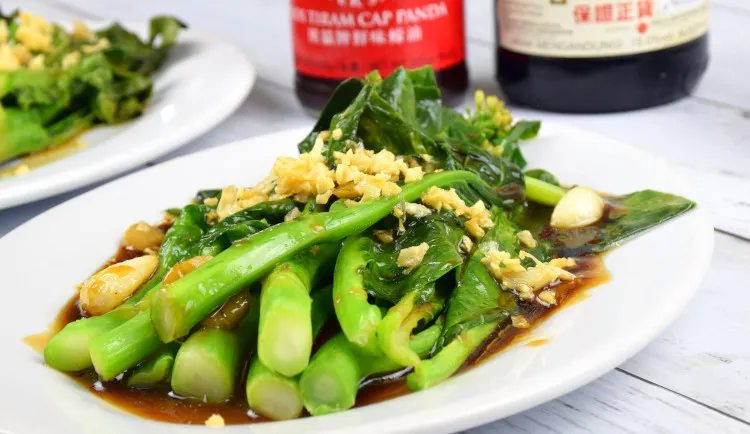
Two methods to cook: Blanching versus stir-frying
There are two ways to cook Chinese broccoli; both are quick and easy.
Method 1- Blanching
Blanch the vegetables in a wok or stockpot filled with boiling water with some oil. The oil will coat the vegetables and leave a glossy sheen.
Here is how to blanch the Chinese broccoli:
- Add some salt to flavor the water. I use approximately one liter of water with a teaspoon of salt for the amount in the Chinese broccoli recipe. Include a quarter teaspoon of baking soda too. Baking soda increases the pH of the water and will ensure the vegetables stay green throughout the cooking.
- Blanch the vegetable for three minutes or until it is tender. How long it takes depends on the size of the stalk. Bigger stalks needed to cook longer naturally. Pick up one to try is the best way to decide when you should remove it from the water.
- Blanching the vegetables with some baking soda will ensure the color remains attractive while serving. This is the preferred method if it is served in a restaurant.
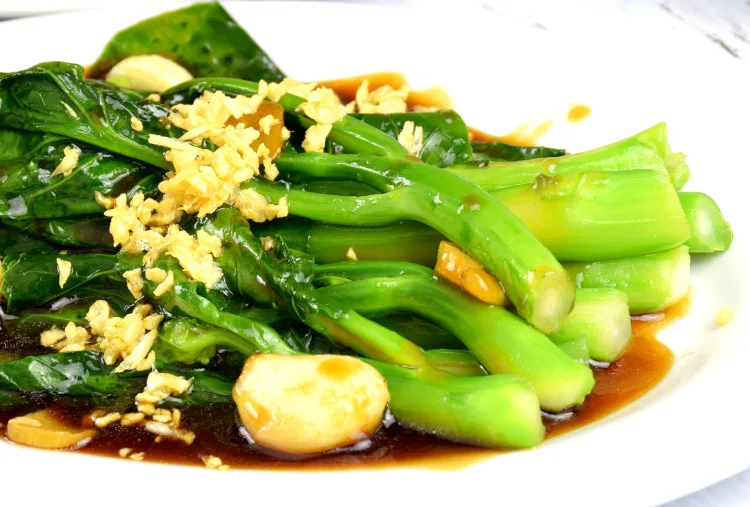
Method 2 – Stir-frying
If you do not want to blanch the Chinese broccoli, you can simplify the process by sauteing it. Here is how to steam the Chinese broccoli and stir-fry it at the same time,
Stir-fry the Chinese broccoli with the garlic and ginger oil in a large wok until tender but remains crispy.
I prefer to stir-fry the vegetable for a minute, follow by adding two tablespoons of water, and put on the wok cover. Let the vegetable steam for three minutes and remove the lid. By then, the water should have evaporated.
Stir-fry the stem part first if it is too thick, as the stem takes longer to turn tender-crisp than the leafy part.
The actual timing depends on the size of the vegetables. Pick up one to try if you want to be sure it cooks perfectly.
You can add a few splashes of Shaoxing wine to the vegetables at the end of stir-frying for extra flavor.
How to serve
To serve, arrange the vegetables on a plate and cut them crosswise into two. Drizzle the sauce on top. Garnish with the fried garlic.
Chinese broccoli (and bok choy) is also served along with some dim sum. For example, it is popular to serve with Cheong Fun.
Related recipes to Chinese broccoli (gai lan)
If you like this Chinese broccoli recipe, you should also check out some related recipes on this blog:
Vegetable stir-fry is a quick and easy Chinese dish. Stir-frying adds a whole new dimension to your plain vegetables, only if you do it right. This article shows you how to blanch the vegetable before stir-frying to get the best result.
Chinese eggplant is tricky to cook because it changes color quickly and easily turns soggy. This recipe shows you all the tricks to keep the color vibrant and prevent them from absorbing too much oil.
Chicken and broccoli stir-fry is a breeze to prepare, all within half an hour or less. If you like Chinese broccoli, chances are you will also like this ‘regular’ dish.
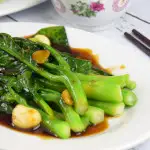
Chinese Broccoli Recipe
Stir-fry of blanched Chinese broccoli is a traditional home-cooked dish for the Chinese. It is also widely served in the restaurants. This recipe shows you step-by-step how to prepare it.
Ingredients
- 250 g Chinese broccoli, weight after trim
- 3 tbsp oyster sauce
- 4 clove garlic
- 5 slices ginger
- 3 tsp light soy sauce
- 1 tsp sugar
- 2 tbsp vegetable oil
- 1 tsp sesame oil
- 1 tbsp of water
- 2 tsp salt
- 1/2 tsp baking soda
Instructions
- Wash the Chinese broccoli. Cut off part of the stem that is tough.
- Peel of the tough fiber n the surface of the stalk with a knife or vegetable peeler.
To blanch:
- Boil about 1 liter of water in a stockpot or the wok.
- Add 1 tablespoon of vegetable oil, 2 teaspoons of salt and a half teaspoon of baking soda.
- Blanch the broccoli for five minute until the stalks are tender. Drained.
- Heat 1 tablespoon of vegetable oil in the pan/wok. Saute the garlic bulb and ginger slices until aromatic.
- Add the oyster sauce, light soy sauce, sugar, and water. Stir until the sugar dissolves.
To stir-fry:
- Heat 1 tablespoon of vegetable oil in the pan/wok. Saute the chopped garlic until golden brown. Remove the garlic and add the ginger slices to continue sautéing for a minute.
- Add the vegetables and stir fry for half a minute.
- Add 2 tablespoons of water and cover with a lid. Let it cook for 5 minutes.
- Remove the lid and continue to stir-fry until the water is dried out.
- Combine the oyster sauce, light soy sauce, sugar, sesame oil, and water. Heat up in a small pot until the sugar dissolves.
To serve:
- Place the vegetables on a serving plate, cut the Chinese broccoli lengthwise into two.
- Drizzle the sauce onto the vegetable.
- Garnish with fried garlic and serve.
Recommended Products
As an Amazon Associate and member of other affiliate programs, I earn from qualifying purchases.
-
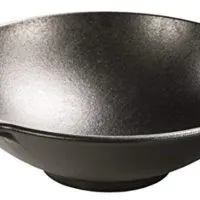 Lodge 14 Inch Cast Iron Wok. Pre-Seasoned Wok with Flattened Bottom for Asian Stir Fry and Sautees
Lodge 14 Inch Cast Iron Wok. Pre-Seasoned Wok with Flattened Bottom for Asian Stir Fry and Sautees -
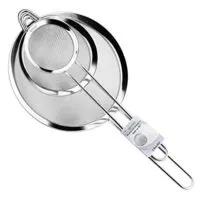 IPOW IP01115 Stainless Steel Fine Tea Mesh Strainer Colander Sieve with Handle for Kitchen Food Rice Vegetable, Set of 3
IPOW IP01115 Stainless Steel Fine Tea Mesh Strainer Colander Sieve with Handle for Kitchen Food Rice Vegetable, Set of 3 -
 Lee Kum Kee Panda Brand Oyster Sauce (18 oz.) (Pack of 2)
Lee Kum Kee Panda Brand Oyster Sauce (18 oz.) (Pack of 2) -
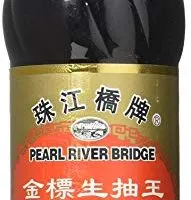 Pearl River Bridge Golden Label Superior Light Soy Sauce, Plastic Bottles, 16.9 oz
Pearl River Bridge Golden Label Superior Light Soy Sauce, Plastic Bottles, 16.9 oz
Nutrition Information:
Yield: 2 Serving Size: 1Amount Per Serving: Calories: 203Total Fat: 17gSaturated Fat: 2gTrans Fat: 0gUnsaturated Fat: 14gCholesterol: 0mgSodium: 3932mgCarbohydrates: 12gFiber: 3gSugar: 3gProtein: 3g
This data was provided and calculated by Nutritionix on 6/17/2019

Broccoli with mushrooms stir-fry- easy and healthy recipe
Saturday 22nd of November 2025
[…] Instead of broccoli florets, you can use Gai Lan (Chinese broccoli). […]
How to Make Hong Shao Rou (Braised Pork Belly) at Home
Tuesday 12th of August 2025
[…] fat and add freshness, I recommend serving it with simple, crisp green vegetables such as bok choy, Chinese broccoli, or […]
How to make Seasoned Soy Sauce - a.k.a. Steamed Fish Sauce 蒸鱼豉油
Saturday 24th of May 2025
[…] Veggies: Toss with bok choy, gai lan, or mushrooms while stir-frying. Add a splash of Shaoxing wine and a bit of minced garlic for extra […]
Chinese Broccoli (Gai Lan): A Versatile and Nutrient-Packed Green -
Saturday 30th of November 2024
[…] For a more in-depth look at preparing Chines broccoli, check out Taste Asian Food’s guide. […]
C King
Saturday 6th of April 2024
So pleased to have found this site. I was reading your pages about cooking bok choy and found your link to Gai Lan. I grew Gai Lan this year and didn't eat much of it as it was tough as old boots and very bitter. I wasn't going to grow it again but I will try next spring and cook it this way. I love my greens, especially my fast growing Asian greens. Gai Lan seeds sprout so easily and it is so easy to grow that I don't want to give up on it.